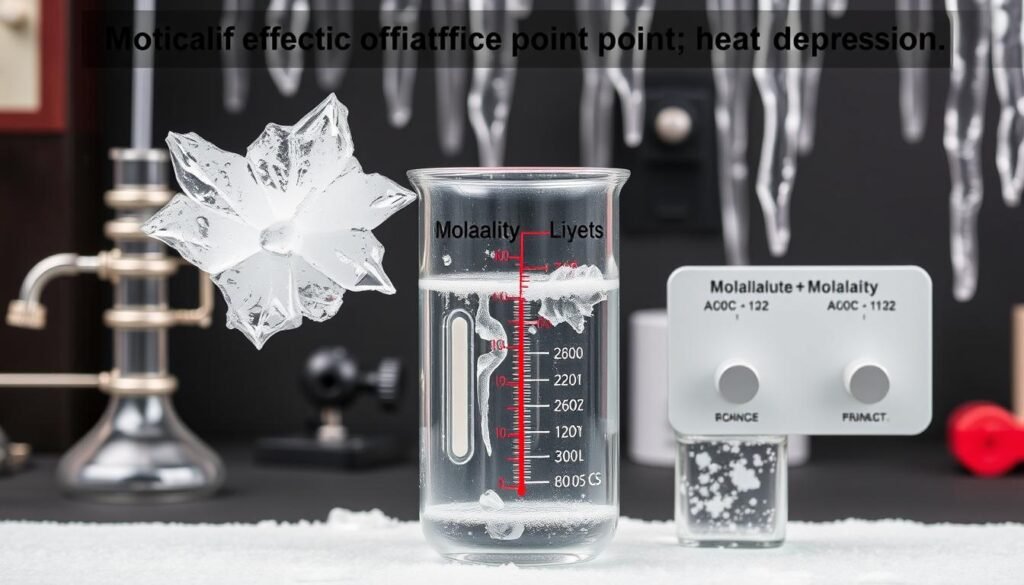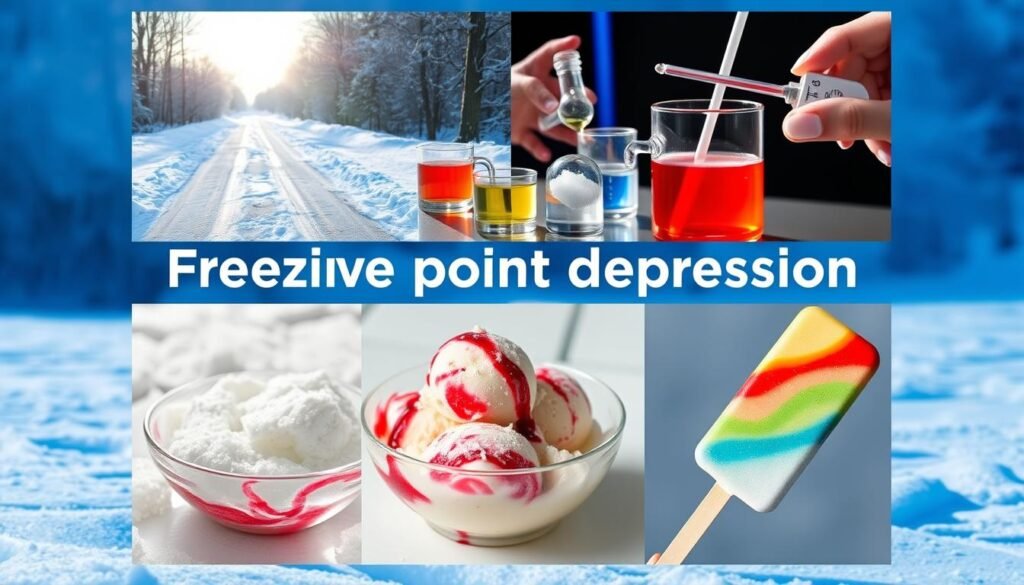Ever wondered why roads become safer in winter when we add salt? This is due to a process called freezing point depression, a key concept in chemistry. It shows how solute additions affect solvent properties. For example, adding sodium chloride (salt) to water lowers the water’s freezing point. The freezing point depression formula, \(\Delta T_f = K_f \times m\), mathematically explains this effect.
These ideas are vital for chemistry students and have practical uses in many sectors. They help in things like road de-icing and studying the environment. To learn more, you can check out detailed resources such as LibreTexts Chemistry.
Key Takeaways
- The freezing point depression formula is crucial in understanding how solutes affect solvent properties.
- The formula \(\Delta T_f = K_f \times m\) highlights the role of molality in the freezing point depression of solutions.
- Colligative properties, including freezing point depression, are important in numerous scientific applications.
- Sodium chloride decreases the freezing point of water, making it effective for winter road treatment.
- The value of the freezing point depression constant varies across different solvents.
- Dissociation of solutes, as reflected by the van’t Hoff factor, significantly influences freezing point calculations.
Introduction to Freezing Point Depression
Freezing point depression is a key idea in solution chemistry. It shows how adding solutes affects the freezing point of solvents. This change happens because solute particles disrupt how solvent molecules organize into a solid.
This disturbance means solutions freeze at lower temperatures than pure solvents. The main cause is the effect of solute particles. They mix up the neat order of solvent molecules. So, more energy is needed to turn the mix into a solid. This lowers the freezing point.
The formula for freezing point depression, ΔTf = i × Kf × m, is key. It includes van ‘t Hoff factor (i), cryoscopic constant (Kf), and the solution’s molality (m). Each solvent has its Kf value. For instance, water’s Kf is 1.86 °C/molal. Benzene’s Kf is 5.12 °C/m. These values help us use the concept in real life.
If you want more info, check out resources like this guide for deeper understanding.
Understanding Colligative Properties
Colligative properties help us see how solute particles affect how solvents act. These properties focus on the number of solute particles, not what they are. The main properties are vapor pressure lowering, boiling point elevation, and freezing point depression.
When solute particles mix into a solvent, things change. A key change is vapor pressure drops. This happens because solute molecules take up space on the surface. They block solvent molecules from escaping into the air. Because of this, vapor pressure goes down, making the boiling point go up. To boil, the solution needs more energy because of this new hurdle.
Colligative properties are used in many areas like chemistry and environmental science. Knowing how solute levels change boiling points and vapor pressure helps solve real problems. For instance, the van’t Hoff factor (i) is crucial when working with ionic solutes. It tells us how many particles a solute breaks into, affecting vapor pressure and boiling point.
Colligative properties show us how important solute levels are. They change how solvents work. This leads to better ways to understand how solutions behave in different situations.
What is the Freezing Point Depression Formula?
The freezing point depression formula is a key equation in chemistry. It shows how adding something to a liquid can lower its freezing point. This idea is very useful in things like keeping food fresh and in car care.
By looking at how the liquid and added substance work together, we can predict changes in freezing points. This helps in many practical situations.
Mathematical Representation of the Formula
The formula is written as ΔTf = Kf × m. Here’s what each part means:
- ΔTf stands for the change in freezing point. It’s the difference between the liquid alone and the liquid with something dissolved in it.
- Kf is a constant that shows how much the freezing point drops per mole of added substance per kilogram of liquid. For water, it’s 1.86 °C/m.
- m is about how much of the substance is dissolved, in moles, in one kilogram of liquid.
Components of the Formula Explained
Every part of the freezing point depression formula has a role. The van’t Hoff factor (i) is important for electrolytes like salt (NaCl), which has a van’t Hoff factor of 1.9. This factor looks at the particle number in solution, affecting the total freezing point change.
Understanding this formula allows for exact calculations in science and real-life uses. Knowing this equation helps explain why certain mixtures behave the way they do. It’s crucial for chemists and others in science.
The Role of Molality in Freezing Point Depression
Molality helps us understand how a solution’s freezing point gets lower. It shows how much solute is in a solvent, in moles per kilogram. This effect on freezing point is key for precise calculations in labs and real-world uses.
Definition and Importance of Molality
Molality is vital for many scientific uses. It shows how solute concentration lowers a solution’s freezing point. The formula Δt = i Kf m links molality to freezing point temperature drops.
A higher molality means the freezing point goes down more. This is crucial in chemistry and environmental studies. For instance, water’s freezing point changes with added salts or sugar, important for figuring out how much it drops.
Calculating Molality in Solutions
Figuring out molality is pretty simple. Just divide the moles of solute by the solvent’s mass in kilograms. For example, with 0.5 moles of sucrose in 0.2 kg of water:
| Component | Value |
|---|---|
| Moles of Sucrose | 0.5 moles |
| Mass of Water | 0.2 kg |
| Molality (m) | 2.5 m |
This molality affects the solution’s freezing point. As mentioned, it’s crucial for precise melting point determination. It’s especially useful in making antifreeze or road de-icing agents. Learning how to calculate molality improves experiment accuracy and creates effective solutions for many uses. Calculating molality is key in such work.

Freezing Point Depression Constant: \(K_f\)
The constant known as \(K_f\) is key to see how solute molecules impact a solvent’s freezing point. Different solvents have different \(K_f\) values. This tells us a lot about their properties. When solute is added, the solvent’s freezing point goes down. This is called freezing point depression. It is linked to the solute’s molality.
Understanding Different Constant Values for Solvents
Every solvent comes with its unique \(K_f\) value. This shows its sensitivity to solute addition. Take water, for instance. Its \(K_f\) value is around -1.86 °C/m. If you dissolve 1 mole of nonvolatile solute in one kilogram of water, the freezing point drops by 1.86 °C. Here are some common solvents and their \(K_f\) values:
| SOLVENT | FREEZING POINT DEPRESSION CONSTANT (\(K_f\)) |
|---|---|
| Water | -1.86 °C/m |
| Acetic Acid | -3.90 °C/m |
| Benzene | -5.12 °C/m |
| Phenol | -7.27 °C/m |
\(K_f\) values differ, indicating varying changes in freezing points with solute addition. Knowing these constants is useful for temperature sensitive applications. For example, creating antifreeze for cars or preserving food. These values show how solute particles influence a solvent’s physical properties. This affects everyday life and industrial operations.
Applications of Freezing Point Depression
Freezing point depression is vital in everyday life and industries. It shows how solutes affect freezing points, changing how we deal with materials. These examples show its importance in harsh weather.
Real-Life Examples and Practical Uses
One use is putting sodium chloride on roads in winter to stop ice from forming. This salt lowers the water’s freezing point, making driving safer in icy weather. Calcium chloride works even better, reducing the freezing point more than sodium chloride.
Antifreeze, often made from ethylene glycol, uses freezing point depression to keep engine coolants liquid in cold temperatures. This prevents vehicle damage by stopping the cooling system from freezing. Chefs also use it to make ice cream and desserts better. Adding salt or sugar keeps the freezing point low, helping avoid large ice crystals that ruin texture.
Importance in Environmental Science and Chemistry
In environmental science, freezing point depression helps study aquatic ecosystems. Many marine animals adapt to changing salinity, surviving in waters that freeze at lower temperatures. This knowledge is crucial for checking ecological health and understanding climate change effects.
For scientists, freezing point depression is key for finding out solutes’ molar mass. They use it in cryoscopy to check a substance’s purity, ensuring chemicals are high-quality. This property’s role ranges from cooking to environmental work, showing its broad impact.

Freezing Point Depression Formula: Detailed Explanation
The freezing point depression formula is key in seeing how solutes affect a solvent’s freezing point. This detailed formula explanation starts with \(\Delta T_f = K_f \times m\). Here, \(\Delta T_f\) means the freezing point’s change. \(K_f\) is the solvent’s cryoscopic constant, and \(m\) shows the solute’s molality.
Colligative properties are vital here. They mainly depend on the solute particles’ amount, not their type. For instance, adding a non-volatile solute like sodium chloride (NaCl) to water changes the water molecules’ order. This leads to stronger chemical interactions, making the solvent need colder temperatures to freeze.
The following table shows normal freezing points and freezing point depression constants for some solvents:
| Solvent | Normal Freezing Point (°C) | Freezing Point Depression, Kf (°C m-1) |
|---|---|---|
| Water | 0.0 | 1.86 |
| Acetic acid | 16.6 | 3.9 |
| Benzene | 5.5 | 5.12 |
| Chloroform | -63.5 | 4.68 |
| Nitrobenzene | 5.67 | 8.1 |
Freezing point depression is crucial in making ice cream and drugs. It shows why seawater has a freezing point below 0°C. Vodka, too, freezes lower than water due to its solutes.
Examples of Freezing Point Depression Calculation
Learning about freezing point depression gets clearer with real examples. By looking at example problems, the formula makes more sense. It shows how to use the formula in different cases. These examples help us see how theory meets real-world analysis.
Step-by-Step Problem Solving
Let’s think about figuring out a solution’s freezing point. We use the formula Δt = i Kf m. Δt shows the change in freezing point, i is the van ‘t Hoff factor, Kf is the constant, and m is the solution’s molality. For example, adding 31.65 g of sodium chloride (NaCl) to 220.0 mL of water, we start by finding the molality:
- First, get the moles of NaCl: Its molar mass is 58.44 g/mol.
- Calculate those moles: 31.65 g ÷ 58.44 g/mol equals 0.54 moles.
- Then figure out the water’s mass in kg: 220.0 mL of water is about 0.220 kg.
- Next, we find molality: m = 0.54 moles / 0.220 kg, which is roughly 2.45 m.
With the van ‘t Hoff factor for NaCl at 2, and Kf for water being 1.86 °C/m:
- We find Δt = i Kf m = 2 times 1.86 °C/m times 2.45 m, which is around 9.10 °C.
This means the freezing point drops by about 9.10 °C. So, the new freezing point is near -9.10 °C.
Analysis of Real-World Scenarios
Freezing point depression isn’t just for class problems. It’s key in real things like refrigeration systems. Knowing the freezing point of brine, with salt in it, is vital for cooling things efficiently. The right calculations are crucial here.
Road salt in winter is another example. It drops the ice’s freezing point. This stops ice from getting too hard and keeps roads safe. To dive deeper, look at a detailed article here.
Factors Affecting Freezing Point Depression
The freezing point of a solution changes due to the solute type. Electrolytes and nonelectrolytes deeply affect how much the freezing point drops. Knowing these effects helps us predict changes in the solvent’s freezing point.
Types of Solutes: Electrolytes vs. Nonelectrolytes
Electrolytes break into ions in a solution. This increases solute particles, lowering the freezing point more. Nonelectrolytes do not turn into ions and add fewer particles. This is a key factor influencing freezing point depression.
Take sodium chloride (NaCl) for instance. In water, it splits into Na+ and Cl– ions. But glucose stays as one particle in solution. Thus, NaCl drops the freezing point more than glucose because it creates more particles, showing a higher van ‘t Hoff factor, \(i\).
The formula \(\Delta{T_f} = i \times K_f \times m\) shows this. \(\Delta{T_f}\) is how much the freezing point drops. \(K_f\) is the constant for freezing point depression, and \(m\) is molality. This proves electrolytes affect freezing points more than nonelectrolytes, showing the importance of solute types.
Different solutes and solvents interacting is critical for practical use. Like using calcium chloride (CaCl2) on roads. It lowers water’s freezing point to melt ice. This proves the real-world use of electrolytes. For more on freezing point depression, visit this resource.
Impact on Daily Life and Industry
Freezing point depression is key in our daily lives and industries. It shows us how important this concept is for regular tasks and new ideas.
Use in Food Preservation
Freezing point depression is crucial in keeping food fresh longer. Think about ice cream. This method helps it stay creamy and smooth in the freezer. Sugar and other substances lower the freezing point.
This makes the ice cream soft instead of hard. When we freeze fruits with added sugars, they keep their tasty flavors and textures. This trick lets us enjoy fruits even after they’ve been frozen.
Role in Antifreeze and Automotive Solutions
In cold weather, antifreeze keeps cars running smoothly. It uses a trick called freezing point depression. Adding things like ethylene glycol to water means it won’t turn into ice. This keeps car engines from getting damaged in winter.
This method is vital for cars to work well all year. It’s a smart way to ensure our vehicles are reliable no matter the season.

| Application | Details | Benefits |
|---|---|---|
| Food Preservation | Ice cream production and freezing fruits | Maintains texture and flavor |
| Automotive Antifreeze | Formulation using ethylene glycol | Prevents freezing damage in engines |
| Road Treatments | Salting icy roads | Improves safety and mobility during winter |
Freezing point depression affects food safety and car reliability. It’s a great example of how chemistry helps us in everyday life. It proves how crucial it is in our modern world.
Conclusion
In summary, freezing point depression is very important. It shows how adding something to a liquid can lower its freezing point. This is crucial in science and in real-life uses. For example, different liquids like water and ethanol freeze at different temperatures when we add other substances.
Moreover, this idea is not just for scientists. It affects our daily lives and several industries. Cars use a mixture of water and ethylene glycol to stop the engine from freezing. Some fish produce their own antifreeze to survive in cold waters. This shows how widespread and crucial freezing point depression is.
So, when we wrap up our discussion, we see that freezing point depression links theory to practice. It has big roles in environmental science, keeping food safe, and in designing chemicals. As we understand more, we can make better technologies and improve in many areas.